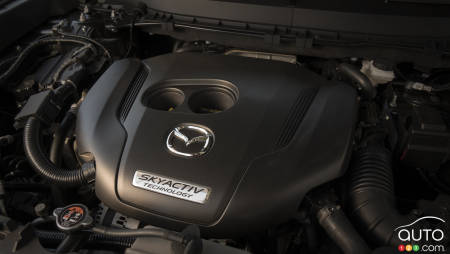What are the 10 best engines of 2017? After evaluating 40 different vehicles last fall (none with a base price higher than $62,000 USD), the editors at WardsAuto—one of the most reputable sources of information in the auto industry—recently published their ranking, which includes seven turbos and three hybrids.
The winning automakers were honoured at a special ceremony in Detroit during the 2017 North American International Auto Show earlier this month.
For the first time in 23 years, V8 engines are completely absent—and it should come as no big surprise if you’ve been following the auto business lately. Downsizing is all the rage, with forced induction, direct fuel injection, and even electrification boosting output to levels previously achieved only by bigger mills.
3.0L turbocharged DOHC I-6 (BMW M240i)
More than the new M2’s 365hp N55 engine, the B58 turbo 6-cylinder in the M240i impressed WardsAuto. “It’s slippery fast and incredibly smooth, while consuming less fuel than some of the 4-cyl. turbos we tested.” It now produces 335 hp (+15) and 369 lb-ft of torque, which is more than the M2, sprinting from 0-60 mph (97 km/h) in 4.4 seconds.
1.5L DOHC 4-cyl./Dual Motor EREV (Chevrolet Volt)
General Motors’ second-generation Voltec drivetrain remains one of the most innovative and disruptive propulsion systems ever produced, according to WardsAuto. In addition to generating nearly 300 lb-ft of instantaneous torque, it provides an all-electric range of 85 km and seamlessly turns into a quiet and comfortable long-distance cruiser with the intervention of the 1.5L gasoline engine.
Don’t miss our latest Chevrolet Volt Review.
3.6L DOHC V-6/Dual Motor PHEV (Chrysler Pacifica Hybrid)
The unique powertrain employs dual electric motors and a heavily revised 3.6L V6 to cover up to 53 km in EV mode and more than 900 km total, with a real-world fuel consumption of just 7.8L/100 km. A game-changer, the Pacifica Hybrid dazzled WardsAuto by “providing a seamless and efficient driving experience without sacrificing abundant interior space and comfortable ride and handling.”
2.3L turbocharged DOHC 4-cyl. (Ford Focus RS)
The most exhilarating to drive among the 40 powertrains tested by WardsAuto this year, the 2.3L turbocharged 4-cylinder in the high-strung, track-ready Focus RS unleashes its 350 hp (and 350 lb-ft of torque) with no interruption as it goes from standstill to light speed. It also makes this car a surprisingly civil daily driver—and Auto123.com’s Sport Compact of the Year.
2.0L DOHC 4-cyl./Dual Motor HEV (Honda Accord Hybrid)
Among hybrids, this may be the best balance yet of performance and fuel economy. Pairing a 2.0L Atkinson-cycle 4-cylinder with an electric motor for a total output of 212 hp, not to mention 232 lb-ft of torque from 0-2,000 rpm, the Accord Hybrid’s system can fool many drivers into thinking they’re not piloting a gas-electric hybrid at all. Meanwhile, some WardsAuto judges achieved 5L/100km.
Don’t miss our 2017 Honda Accord Hybrid Review.
1.4L turbocharged DOHC 4-cyl. (Hyundai Elantra Eco)
Sadly, this little engine, known as “Kappa,” is not available in Canada, only in the U.S. That’s a shame because it’s said to deliver refinement (helped by a quick-shifting 7-speed dual-clutch transmission), performance (feels more robust than its 128hp rating) and fuel economy (5.8L/100km).
On the other hand, the new 2017 Hyundai Elantra and Elantra Sport are quite impressive themselves…
3.0L turbocharged DOHC V6 (Infiniti Q50 Red Sport 400)
This spectacular 400hp 3.0L twin-turbo V6 puts Infiniti neck-and-neck with its German competitors in the powertrain department, WardsAuto editors argue (“step on the gas and be prepared for a wallop that slams you into the seatback”). It’s also silky-smooth, quiet when you want it to be, and capable of delivering respectable fuel economy (10.2 L/100 km).
We have no fewer than four reviews of the new Infiniti Q50, including two in Red Sport 400 trim, so check them out now. By the way, you can also get the 400hp engine in the redesigned Q60 coupe:
2.5L turbocharged DOHC 4-cyl. (Mazda CX-9)
Who better than Mazda with its SKYACTIV technology to sell us on the idea of putting a 4-cylinder engine into a 7-passenger CUV? Turbocharging, direct fuel injection, and a smart cylinder-head design help this 2.5L mill deliver excellent low and mid-range torque like a big V6. You can get 227 hp with regular gas or 250 hp with premium—the latter perfect for extracting all the “Zoom-Zoom” out of the big Mazda.
Don’t miss our reviews of the Mazda CX-9, Auto123.com’s Midsize SUV of the Year.
2.0L turbocharged DOHC 4-cyl. (Mercedes-Benz C 300)
The numbers here are respectable enough (241 hp, 273 lb-ft of torque), but it’s the way power is delivered that amazed WardsAuto judges. Hitting peak torque at just 1,300 rpm, “the direct-injected engine pulls hard from launch to redline, all while maintaining a smooth and silky refinement that belies its punchy performance.”
We tested the C 300 4MATIC Coupe last summer, so click on the link for more info.
2.0L turbocharged/supercharged DOHC 4-cyl. (Volvo V60 Polestar)
Yet another 2.0L four, but this one comes with a twist: It uses both turbocharging and supercharging, which results in 362 hp, or 181 hp/L. Incredible, isn’t it? Compared to the XC90’s T6 (316 hp), this reworked engine gets a bigger turbocharger, new connecting rods, new camshafts, a larger air intake, and a higher-capacity fuel pump. Plan 4.5 seconds to go from 0-60 mph (97 km/h).







